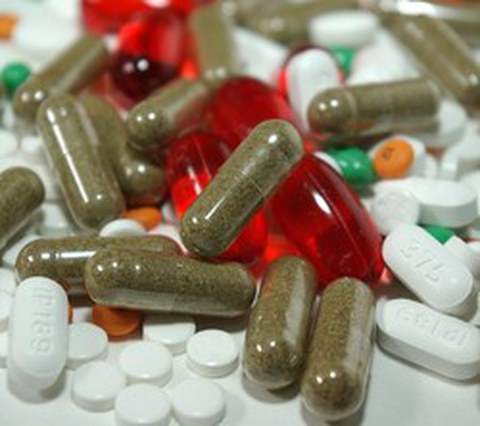Environmental behaviour of pharmaceuticals
The presence of active pharmaceutical ingredients (API) in the environment has been a growing concern in recent years. Around 2300 different API are being administered, and it is estimated that more than 8 000 t of drugs are being consumed - annually alone in Germany. 1200 of these pharmaceuticals are considered environmentally relevant since they are Persistent, Bioaccumulative or Toxic (PBT). So far 150 different API have been detected in waste water effluents, in surface water, ground water and drinking water in Germany. Even though the concentrations are very low (ng/L to µg/L) they may cause a threat not only to aquatic and terrestrial organisms but also to human health. Together with the University of Gdańsk and the group of Prof. Piotr Stepnowski we are investigating the environmental behaviour of several different types of drugs such as antibiotics, anti-diabetics, anthelmintics, beta-blockers, anti-inflammatoy drugs and contraceptives. Thereby we address various research topics:
- development of analytical methods
- ecotoxicity assessment of pharmaceuticals, their mixtures and their transformation products
- abiotic and biotic degradability under various environmental conditions
- elucidation of degradation pathways
- waste water treatment
For further information please have a look at our recent publications:
Bialk-Bielinska A., Matzke M., Caban M., Stolte S., Kumirska J., Stepnowski P., (2018) Effects of five sulphonamides on duckweed (Lemna minor) after prolonged exposure time and their dependency on photoradiation. The Science of the Total Environment, 18, 952-960.
Bialk-Bielinska A., Mulkiewicz, E., Stokowski M., Stolte, S., Stepnowski P. (2017) Acute aquatic toxicity assessment of six anti-cancer drugs and one metabolite using biotest battery - Biological effects and stability under test conditions. Chemosphere, 189, 689-698.
Bialk-Bielinska A., Matzke, M., Caban, M., Stolte, S., Kumirska, J., Stepnowski, P. (2017) Effects of five sulphonamides on duckweed (Lemna minor) after prolonged exposure time and their dependency on photoradiation. Science of the total environment. DOI 10.1016/j.scitotenv.2017.08.286
Bialk-Bielinska A., Mulkiewicz E., Stokowski, M., Stolte S., Stepnowski P. (2017) Acute aquatic toxicity assessment of six anti-cancer drugs and one metabolite using biotest battery - Biological effects and stability under test conditions. Chemosphere 189, 689-698.
Wagil M. et al. (2015) Toxicity of anthelmintic drugs (fenbendazole and flubendazole) to aquatic organisms. Environmental Science and Pollution Research 22, 2566–2573. Free full text available under: ResearchGate
Markiewicz M., Jungnickel C., Stolte S., Białk-Bielińska A., Kumirska J., Mrozik W., (2017) Ultimate biodegradability and ecotoxicity of orally administered antidiabetic drugs. Journal of Hazardous Material 333, 154-161 doi.org/10.1016/j.jhazmat.2017.03.030
Puckowski A., Stolte S., Wagil M., Markiewicz, M., Lukaszewicz, P., Stepnowski, P., Bialk-Bielinska, A. (2017) Mixture toxicity of flubendazole and fenbendazole to Daphnia magna. International journal of hygiene and environmental health 220, 3, 575-582 (DOI: 10.1016/j.ijheh.2017.01.011).
Białk-Bielińska A., Caban M., Pieczyńska A., Stepnowski P., Stolte S. (2017) Mixture toxicity of six sulfonamides and their two transformation products to green algae Scenedesmus vacuolatus and duckweed Lemna minor. Chemosphere 173, 542-550. DOI 10.1016/j.chemosphere.2017.01.035
Wagil M., et al. (2014) Development of sensitive and reliable LC-MS/MS methods for the determination of three fluoroquinolones in water and fish tissue samples and preliminary environmental risk assessment of their presence in two rivers in northern Poland. Science of the Total Environment 493, 1006–1013. Free full text available under: ResearchGate
Fabianska A., et al. (2014) Electrochemical degradation of sulfonamides at BDD electrode: kinetics, reaction pathway and eco-toxicity evaluation. Journal of Hazardous Materials 280, 579–587. Free full text available under: ResearchGate
Maszkowska J., et al. (2014) Beta-blockers in the environment: Part I. Mobility and hydrolysis study. Science of the Total Environment 493, 1112–1121. Free full text available under: ResearchGate
Kolodziejska M., et al. (2013) Aquatic toxicity of four veterinary drugs commonly applied in fish farming and animal husbandry. Chemosphere 92(9), 1253-1259. Free full text available under: ResearchGate
Contact:
Prof. Dr. Stefan Stolte

